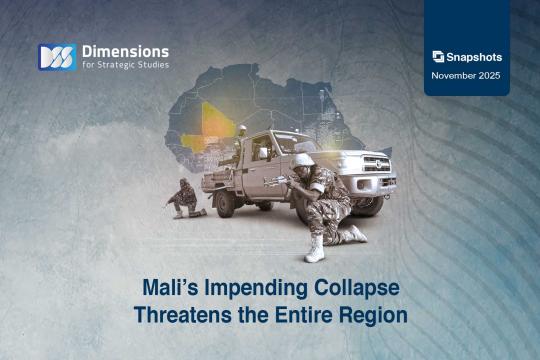
Can Somalia Win against Al-Shabaab?
2024-05-112138 view
In late August 2023, Somali President Hassan Sheikh Mohamud announced that he had given the country’s armed forces five months to eliminate what remained of al-Shabaab and complete Operation Black Lion. The campaign, launched a year earlier, had seized dozens of villages back from the jihadist movement in the states in central Somalia, comprising the regions of Mudug, Galmudug, and Hirshabelle.
The operation aimed to wipe out Al-Shabaab and seize back its strongholds in the south (Lower Shabelle, Juba, Bay and Bakool states). But the campaign faltered soon after being launched. The group resisted hard and launched effective counterattacks, twice seizing and withdrawing the city of Dhuusamareeb, which had hosted the government’s command headquarters. The Shabaab also managed briefly to take control of other cities in the central region.
The lack of a breakthrough prompted the Somali government to change its objectives during the second phase of the operation, directing its efforts to taking control of the Al-Shabaab strongholds in the central regions of Galguduud and Middle Shabelle. The movement took advantage of this to regroup, and absorbed the government’s attacks, retaking the vast territories it had lost, as well as waging an ongoing war of attrition against government forces.
This year, Al-Shabaab has dramatically stepped up its operations, both inside Somalia and in the Somali tribal areas that make up northeastern provinces of Kenya. The group has carried out some 30 military operations against Kenyan military convoys and outposts in the districts of Lamu, Garissa, Wajir and Mandera. This adds up to between five and 12 attacks a month, up from three to six per month throughout 2023, reflecting a dramatic escalation of Al-Shabaab attacks inside Kenyan territory.
In Somalia, the movement has carried out 340 attacks against security forces since the beginning of 2024, mostly in the central and southern states. During March, the bloodiest month, the movement regained control of several cities in Mudug state, as well as expanding its operations in and around Mogadishu, especially the nearby coastal areas of Bosli and Jazeera, where it carried out large-scale operations and briefly took control of several military bases before withdrawing again.
It also stepped up attacks in the states of Lower and Middle Shabelle and laid siege to the strategic city of Harardhere. For a few days it took control of the city of Dar al-Naima, and attempted to seize the city of Bal’ad. The group also launched a string of intense attacks against African and government forces at military bases in several cities in the states of Lower Shabelle and Southern Bay.
In mid-March, al-Shabaab stormed Mogadishu’s Syl Hotel, targeted a meeting of tribal militia leaders and security agencies. This attack showed the extent of the movement’s ability to infiltrate government institutions, as well as confirming that the government’s security measures were insufficient to prevent it from carrying out complex attacks. Indeed, the Shabaab’s ability to carry out such wide-ranging attacks marks a qualitative shift in its capacities against its foes, and the group is likely to continue to mount major operations against government and foreign forces in the coming months.
The government is determined to launch the final phase of Operation Black Lion campaign in May 2024, in order to benefit from the support of African Union forces, which have already begun their withdrawal from Somalia. They are expected to complete their withdrawal by the end of 2024, but there are no guarantees that the government will be able to dismantle al-Shabaab and retake territories the group controls within such a short timeframe.
Al-Shabaab draws much of its strength from its flexibility. It has a presence across large areas of southern Somalia, where it operates multiple security, military and judicial organs. The city of Jilib in southwestern Somalia is the group’s de facto capital, but it is constantly expanding then retreating in the face of military campaigns. Its armed wing carries out a wide variety of operations including assassinations, attacks of attrition, bombings and regular ambushes, as well as major, multi-axis attacks against specific cities, towns, and military bases.
In light of its escalating operations within Mogadishu and the periphery of government-controlled areas, it may be concluded that the group can easily project power into these areas and carry out major operations there.
The movement has also threatened tribes that have set up militias to cooperate with government forces, by threatening to cut off trade routes and prevent vital supplies from reaching them, as well as by assassinating prominent tribal figures.
The withdrawal of the African Union Transition Mission in Somalia (ATMIS) is expected to prompt al-Shabaab to escalate its operations, especially as the bulk of its attacks hitherto have been directed against ATMIS forces. This suggests that the movement will make a strong comeback in central and southern Somalia in 2025, potentially taking control of prominent cities such as Genale, Afmadow, Afgoye and Kismayo. It will also pose a regional threat along the Ethiopian border and in regions of Kenya adjacent to Somalia—the three coastal provinces of Lamu, Garissa and Mandera.
The balance could tip in favor of the government again if Mogadishu were able to persuade tribes in the center and south of the country to fight on its side. This would put pressure on al-Shabaab, preventing the movement from taking control of strategic cities. However, it would not prevent it from adapting to the new reality and re-inventing its strategy of attacks against the government and its allies.





